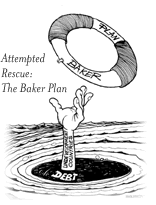|
The
Baker Plan, proposed by U.S. Treasury Secretary James Baker in 1985,
envisioned further concessions by all three parties involved: commercial
banks and multilateral financial institutions would increase lending,
while indebted countries would make greater efforts at fiscal, financial,
and monetary reform.
Initial enthusiasm for the Plan quickly faded. The Baker Plan had
only limited success because it merely delayed payment of the debt,
rather than reducing it.
|

credits
|